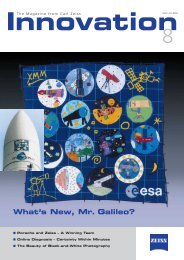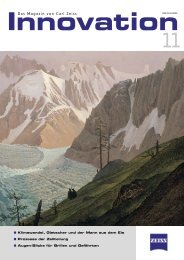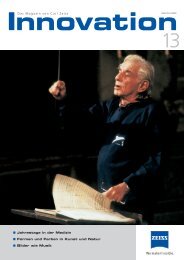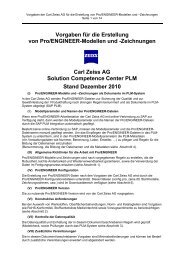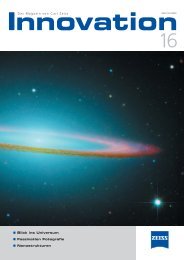Download PDF - Carl Zeiss
Download PDF - Carl Zeiss
Download PDF - Carl Zeiss
You also want an ePaper? Increase the reach of your titles
YUMPU automatically turns print PDFs into web optimized ePapers that Google loves.
Angelo Secchi (1818-1878)<br />
split the light of the stars and the sun<br />
into their components using prisms.<br />
The breakdown of the color spectra<br />
and dark absorption lines allowed the<br />
chemical composition of the solar and<br />
stellar atmosphere to be determined:<br />
four different spectral classes were created.<br />
Secchi's pioneering discoveries are<br />
thought to have prepared the way for<br />
spectral analysis.<br />
Modern technics<br />
A planetarium’s instruments are used<br />
to create an artificial night sky.<br />
Today, fiber optic technology enables<br />
representations so brilliant that<br />
they outshine the real stars. The most<br />
promising advanced projection technology<br />
is the development of the<br />
so-called digital planetarium: the projection<br />
of full-dome video using video<br />
projectors. A particularly major step<br />
in this direction was taken with the<br />
ZULIP (<strong>Zeiss</strong> Universal Laser Image<br />
Projector), which allows mobility of<br />
the attached video projector. It operates<br />
on the basis of laser light and<br />
Innovation 16, <strong>Carl</strong> <strong>Zeiss</strong> AG, 2005<br />
6<br />
7<br />
creates sensationally high-contrast images<br />
of previously unsurpassed sharpness.<br />
The first ZULIP was presented<br />
during the IPS 2000 Conference at<br />
the Montreal Planetarium. The further<br />
development of ZULIP into ADLIP (All<br />
Dome Laser Image Projector) now<br />
enables the projection of dome-filling<br />
video sequences using several permanently<br />
installed ZULIPs. But whether a<br />
planetarium is small or large, visitors<br />
are always at the heart of the action.<br />
The very first suggestion for the construction<br />
of a planetarium that would show the sky in<br />
realistic detail came from Max Wolf (1863-1932),<br />
Director of the Heidelberg Observatory. Oskar<br />
von Miller, who wanted to set up a heliocentric<br />
and a geocentric planetarium in the Deutsches<br />
Museum, took Wolf’s idea to <strong>Carl</strong> <strong>Zeiss</strong> in<br />
1912/13. Walther Bauersfeld (1879-1959) designed<br />
the first projection planetarium. He was a<br />
member of the <strong>Carl</strong> <strong>Zeiss</strong> Board of Management<br />
for 50 years. He had the idea of placing the<br />
movement of the stars, the sun, the moon and<br />
the planets within a projector that would be<br />
installed at the center of a spherical dome.<br />
35




